Stage & Story Gallery – Press
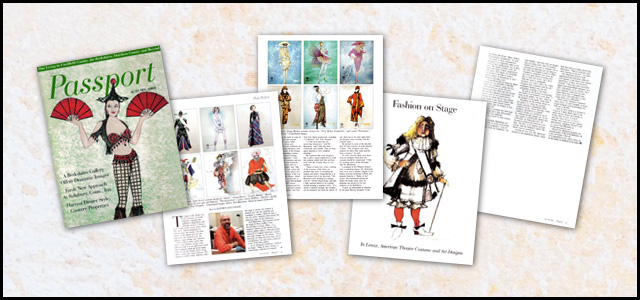
Passport | Kathryn Boughton | Autumn 2008
Fashion on Stage
In Lenox, American Theater Costume and Set Designs
The magic of the theater lies in its evocation of worlds unknown, engaging the audience’s imagination and allowing viewers to believe in the reality of the scenes before them. The actors’ skill is paramount in creating these new worlds, but other aspects of the theater arts are also important-the musical score, the lighting, stage settings and costumes.
But as real as those scenes may seem to the audience sitting in the darkened hall, it is an ephemeral world that disappears when the house lights come up and the theater doors swing open to usher the crowd outdoors. The imagined world is truly dispelled when the stage is struck, the scenery is painted over and the costumes are consigned to trunks. Often all that is left are artists’ sketches done during the planning stages of the production.
Neil Blumstein, who recently moved his Stage & Story Gallery from Stockbridge to Lenox, Mass., is a longtime admirer of the theater arts, and his gallery offers a rich and varied selection of original American costume and stage designs for his clients. “These drawings are often the only trace left of a production,” he said as he conducted a tour of his little gallery.
As its inaugural exhibition, “Fashion on Stage”, Stage & Story Gallery is showcasing a selection of original drawings exploring the work of some of America's leading set and costume designers in theater, opera, ballet, Broadway musicals, circus and television. Included in the exhibition are works by award-winning designers such as Gregg Barnes, winner of the Drama Desk Award for outstanding costume design for the Tony Award-winning musical “Drowsy Chaperone”; Zack Brown, who designed costumes and sets for Washington Opera and American Ballet Theatre productions such as “Turandot”, “Pique Dame” and “The Merry Widow”; Alvin Colt, whose 60-year career is currently the subject of a retrospective at the Museum of the City of New York; and Allen Moyer, whose set designs for the new production of “Orfeo ed Euridice” at the Metropolitan Opera were a Spring 2007 season highlight. His works are represented in the Lenox exhibition by set and costume designs from “Glimmerglass” and New York City Opera productions, including “La Boheme” and “Don Pasquale”.
“I think these drawings are interesting historically,” said Mr. Blumstein “and I also like them esthetically and visually. They go from quick sketches to very complete drawings”.
He explained that some designers like to give a quick impression of what the costume would look like and then work with the costume shop on their creation.
“Some of them only evoke a feeling of the costume, while others are detailed right down to including the sequins and glitter. Gregg Barnes is at the finished end of the spectrum,” Mr. Blumstein said, pointing to a design used for “Flower Drum Song” that had a fully realized sketch of an oriental woman wearing a sequined outfit. “If a sketch is detailed enough, the costume can be produced just from the sketch. If not, there has to be more input from the designer when working with the costume shop”.
He pointed to some of the sketches that still had swatches of cloth attached to them. “The designers have even sourced the fabric they want used for these costumes,” he said.
On other sketches there were notes from the designer about how the costume should be constructed. “I like the working aspect of the drawings,” said Mr. Blumstein.
A graduate of the Wharton School with a marketing degree, Mr. Blumstein went on to earn a master’s degree in art history from the Sorbonne in Paris and attended Sotheby’s “Works of Art” course. An experienced private art dealer, he brings many years of planning and passion to his new endeavor in the Berkshires.
“I grew up surrounded by sketches by the great Russian designers of the pre-World War II era-Bakst, Benois, Dobuzhinsky, Goncharova,” he said. “The work of these contemporary designers is as important today as the work of their predecessors was in their time. The quality of their work, the depth and range of their imaginations and styles, their talent, are incredible. I'm thrilled to be able to bring a greater degree of recognition to these designers and their work”.
“A pre-World War II sketch by Bakst would cost you ‘20,000’ to ‘50,000’ today,” he continued, noting that his collection focuses on the 60 years between the late 1940s and the present. He said his collection concentrates on designs used for live performances, although he added that he may expand in the future to use movie designs. His collection also leans heavily toward costume rather than set designs as they are easier to find.
“You have to consider that there may be three scenes for a play and possibly 100 costumes,” he explained. “Obviously it is easier to find costume designs”.
But even costume illustrations are becoming harder to locate as he avoids designs done on computers. “Lots of designers now work on computers,” he said ruefully, “and even with set designs they are doing more with 3-D models. Models aren’t as easy to integrate into a collection as drawings you can hang on the wall. One designer I used to collect switched to computers five years ago and feels quite proud of having been able to make the switch, but I don’t think her work is comparable anymore-so I don’t collect her. Other designers have remained with the old techniques because they like the spontaneity of doing it free hand”.
He said he has focused on presenting the works of top designers in his shop. “I focus on the quality,” he said, “either of the designer or the quality of the show”.
Rounding out the artwork shown in his gallery is a small but growing section devoted to illustrations from children’s books. Those drawings, while faithfully reproduced in popular children's books, are definitely not to be collected for the younger set. In the same mode is a Gold Label Barbie doll collectible, the Fairytopia doll, all dressed in glimmering iridescent pink tulle. The doll, in its original package, will go with the designer's sketch that Mattel used in creating her.
Turning the box over, Mr. Blumstein pointed to the reproduced sketch, which had been used as a large advertising illustration. “They ‘ve used the exact same drawing on the box,” he noted.
Mr. Blumstein believes both experienced and first-time collectors will respond to the beauty and cultural significance of these one-of-a-kind artworks. “They have great decorative appeal and extraordinary presence on a wall, individually or as a group. And their relatively small size not only makes them easy to integrate into homes of all sizes and style-it also makes them very collectable”.
While earlier designers command hefty prices, he said, examples of more recent designers can be purchased for ‘200 up to 6,000’.
Stage & Story Gallery is located in Lenox at 4 Main Street, next to the public library [NOTE: This gallery space is closed]. Hours are Tuesday to Friday, from 10 a.m. to 6 p.m.; Saturday, from 10 a.m. to 5 p.m.; Sunday, from noon to 4 p.m.; and by appointment-telephone 413-637-1525 or contact Neil Blumstein at neil@stageandstory.com.
Because Mr. Blumstein recognizes the seasonal quality of life in the Berkshires, he is also developing a Web site, www.stageandstory.com, where visitors can see the unique art displayed in his gallery.
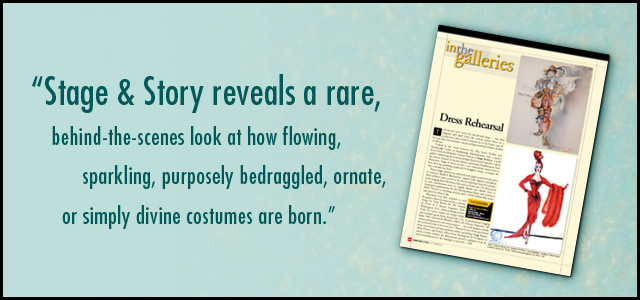
Berkshire Living | Alison McGee | October, 2007
in the galleries: Dress Rehearsal
THE SHOW’S NOT OVER TILL the fat lady sings... but what happens after that? Once the curtain comes down on a production, little is left to remind us of the beauty and effort put into the costumes, except perhaps archived reviews of their excellence.
Tucked in the mews between the Elm Street Market and Stockbridge Coffee in Stockbridge, Massachusetts, only a stone’s throw from the Berkshire Theatre Festival, is Stage & Story, a small gallery celebrating the costume designs that remain long after a show has closed. Started by theater fanatic and former Manhattanite Neil Blumstein, Stage & Story reveals a rare, behind-the-scenes look at how flowing, sparkling, purposely bedraggled, ornate, or simply divine costumes are born.
From rough sketches on yellowed, torn paper scrawled with notes to pristine, finished illustrations topped with sequins and glitter, these artifacts have served as the literal drawing board for productions ranging from Broadway hits such as Mame and The Fantasticks to new productions such as Legally Blonde and Barbie Live! In Fairytopia; performances by the Metropolitan Opera and American Ballet Theatre to traveling circuses and a 1960s Oldsmobile industrial show by Alvin Colt.
Blumstein was first inspired to start the gallery when he came across a costume design by Zack Brown for The Comedy of Errors in a theater magazine from Washington, D.C., while working in New York. He’s since scoped out design talent and costume gens from around the U.S., in productions ranging from 1946’s Around the World to 2006’s The Drowsy Chaperone. “All of these designers serve the same purpose... but each designer attacks the problem in his or her own way,” Blumstein says of the specimens from seven local and international artists, including Gregg Barnes, Allen Moyer, and Arthur Oliver from Shakespeare & Company in nearby Lenox. Indeed, the illustrations provide a glimpse at an art often overwhelmed by the limelight it precedes. &mdash AM
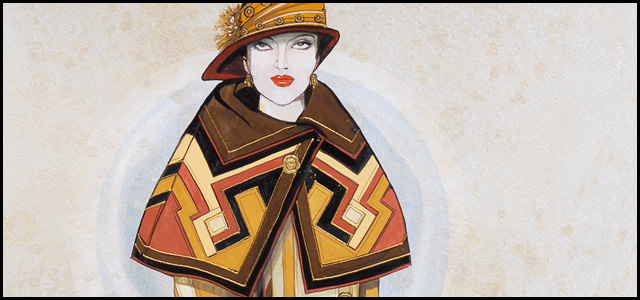
Theater Mania | Brian Scott Lipton | Thursday, August 20, 2007
Garden Variety
Should you make it to the Berskhires to see these shows, or maybe just for the fall foliage, theater lovers should add two stops to their itinerary. First is The Williams College Museum of Art, which is showcasing an excellent exhibition, Making It New: The Art and Style of Gerald and Sara Murphy. This enlightening look at the Golden Age couple who befriended and supported such luminaries as Cole Porter, Dorothy Parker, and even Ms. Hellman — not to mention best pals Ernest Hemingway and F. Scott Fitzgerald — contains paintings, letters, photographs, even carefully framed drawings by the young Murphy children.
Also on your agenda should be the new Stage & Story Gallery in Stockbridge. Owner Neil Blumstein is displaying and selling costume and scenery sketches from local theaters, such as BTF and Shakespeare and Company, as well as works by Broadway designer Gregg Barnes, including sketches from Legally Blonde, The Drowsy Chaperone, and the Kennedy Center production of Mame.
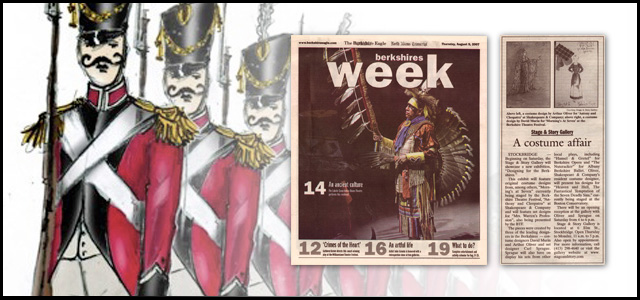
The Berkshire Eagle—Berkshires Week | Thursday, August 09, 2007
Stage & Story Gallery: A costume affair
STOCKBRIDGE — Beginning on Saturday, the Stage & Story Gallery will showcase a new exhibition, “Designing for the Berkshires.”
This exhibit will feature original costume designs from, among others, “Morning's at Seven” currently being staged by the Berkshire Theatre Festival, “Anthony and Cleopatra” at Shakespeare & Company and will feature set designs for “Mrs. Warren's Profession”, also being presented by the BTF. The pieces were created by three of the leading designers in the Berkshires—costume designers David Murin and Arthur Oliver and set designer Carl Sprague. Sprague will also have on display his sets from other local plays, including “Hansel & Gretel” for Berkshire Opera and “The Nutcracker” for Albany Berkshire Ballet. Oliver, Shakespeare & Company's resident costume designer, will present his designs for “Heaven and Hell”, “The Fantastical Temptation of the Seven Deadly Sins”, currently being staged at the Boston Conservatory.
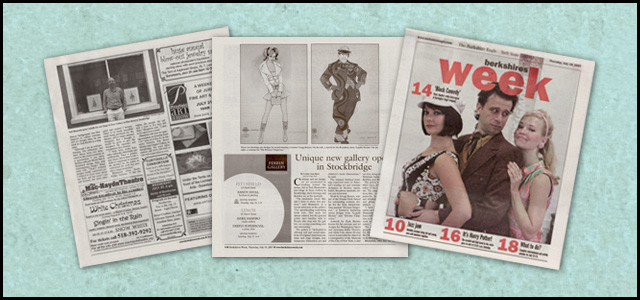
The Berkshire Eagle—Berkshires Week | Lesley Ann Beck | July 19, 2007
Unique new gallery opens in Stockbridge
Costume and set designers are accustomed to working behind the scenes, but at Neil Blumstein’s new Stage & Story Gallery in Stockbridge, their drawings and sketches are in the spotlight.
“I’m passionate about this, and I want to share that passion,” said Blumstein in a recent interview at the gallery. “I’m spearheading something fairly new. This work has always existed, but the general public isn’t familiar with it. People who step into the gallery are seeing something new and interesting”.
The gallery is “dedicated to offering rich and varied selections of original American costume and stage designs, contemporary illustration art and children’s book illustrations,” he said.
The original, finished drawings represent some of America&rsuqo;s leading set and costume designers in theater, opera, ballet, Broadway musicals, circus and television.
Works by Gregg Barnes, winner of the Drama Desk Award for outstanding costume design for the Tony Award-winning musical Drowsy Chaperone, is featured, including actual designs from Legally Blonde and Drowsy Chaperone”.
Artwork by Zack Brown, known for his costume and set designs for Washington Opera and American Ballet Theatre, and Alvin Colt, whose 60-year career is currently the object of a retrospective at the Museum of the City of New York, is also on view, along with work by Ed Wittstein, Anita Yavich, Carrie Robbins and Allen Moyer.
The gallery is a small, bright white space, where the vibrant colors of the renderings stand out. The range of styles is cartoon-like to realistic and painterly. Some are delicate and detailed; others are brash and glitzy. All are accomplished.
“I have the work of seven artists on the walls right now,” Blumstein said. “The second focus will be children’s illustrations in August. I would like to work with local and regional artists.”
Blumstein, who has an art history background, was first inspired to collect costume and set designs when he saw work by Zack Brown in a magazine.
“Although I am an avid performing arts enthusiast, and have always been very interested in the visual elements of a production, I was more familiar with pre-World War II theatrical design than with contemporary design,” Blumstein said. “Zack’s costume designs totally captivated me. I wanted to learn more about the field, and the more I saw and learned, the more interested and excited I became. There is so much incredible work being produced for the theater, and so many talented designers, that I thought it would be great to give the designers the exposure and recognition they deserve”.
“I think these works have value culturally, historically, and aesthetically. Once a production closes, this is what is left. I think it’s important to preserve the sketches for the public to understand the work that goes into a visual production”.
Blumstein chose Stockbridge because, “I like the region, the people, the culture. I want to live here full time,” Blumstein said. “I plan to be open year-round.”
